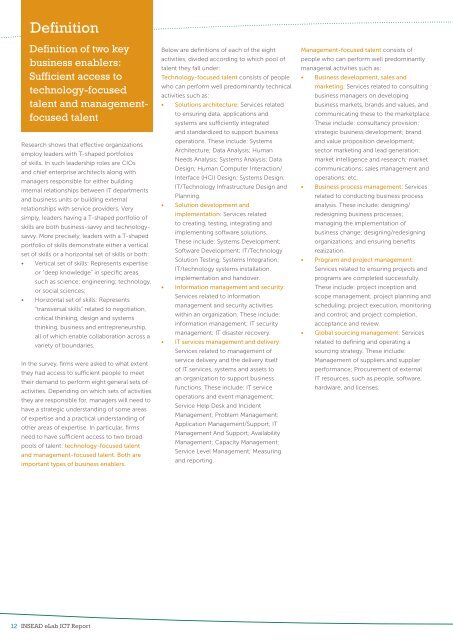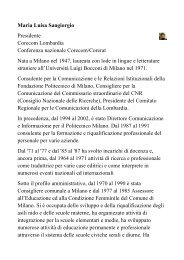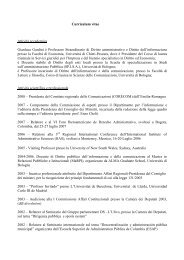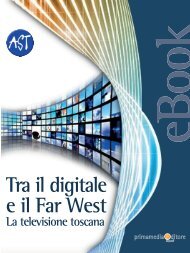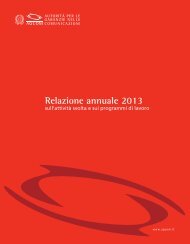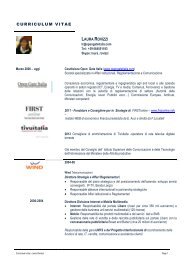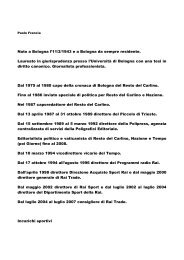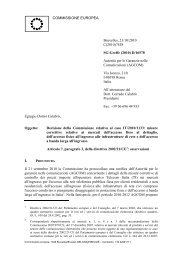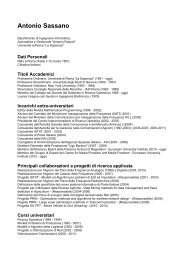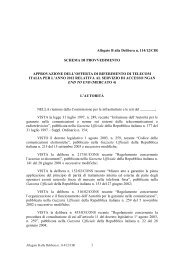Building Competitiveness and Business Performance with ICT
Building Competitiveness and Business Performance with ICT
Building Competitiveness and Business Performance with ICT
- No tags were found...
Create successful ePaper yourself
Turn your PDF publications into a flip-book with our unique Google optimized e-Paper software.
DefinitionDefinition of two keybusiness enablers:Sufficient access totechnology-focusedtalent <strong>and</strong> managementfocusedtalentResearch shows that effective organizationsemploy leaders <strong>with</strong> T-shaped portfoliosof skills. In such leadership roles are CIOs<strong>and</strong> chief enterprise architects along <strong>with</strong>managers responsible for either buildinginternal relationships between IT departments<strong>and</strong> business units or building externalrelationships <strong>with</strong> service providers. Verysimply, leaders having a T-shaped portfolio ofskills are both business-savvy <strong>and</strong> technologysavvy.More precisely, leaders <strong>with</strong> a T-shapedportfolio of skills demonstrate either a verticalset of skills or a horizontal set of skills or both:• Vertical set of skills: Represents expertiseor “deep knowledge” in specific areassuch as science; engineering; technology,or social sciences;• Horizontal set of skills: Represents“transversal skills” related to negotiation,critical thinking, design <strong>and</strong> systemsthinking, business <strong>and</strong> entrepreneurship,all of which enable collaboration across avariety of boundaries.In the survey, firms were asked to what extentthey had access to sufficient people to meettheir dem<strong>and</strong> to perform eight general sets ofactivities. Depending on which sets of activitiesthey are responsible for, managers will need tohave a strategic underst<strong>and</strong>ing of some areasof expertise <strong>and</strong> a practical underst<strong>and</strong>ing ofother areas of expertise. In particular, firmsneed to have sufficient access to two broadpools of talent: technology-focused talent<strong>and</strong> management-focused talent. Both areimportant types of business enablers.Below are definitions of each of the eightactivities, divided according to which pool oftalent they fall under:Technology-focused talent consists of peoplewho can perform well predominantly technicalactivities such as:• Solutions architecture: Services relatedto ensuring data, applications <strong>and</strong>systems are sufficiently integrated<strong>and</strong> st<strong>and</strong>ardized to support businessoperations. These include: SystemsArchitecture; Data Analysis; HumanNeeds Analysis; Systems Analysis; DataDesign; Human Computer Interaction/Interface (HCI) Design; Systems Design;IT/Technology Infrastructure Design <strong>and</strong>Planning.• Solution development <strong>and</strong>implementation: Services relatedto creating, testing, integrating <strong>and</strong>implementing software solutions.These include: Systems Development;Software Development; IT/TechnologySolution Testing; Systems Integration;IT/technology systems installation,implementation <strong>and</strong> h<strong>and</strong>over.• Information management <strong>and</strong> security:Services related to informationmanagement <strong>and</strong> security activities<strong>with</strong>in an organization. These include:information management; IT securitymanagement; IT disaster recovery.• IT services management <strong>and</strong> delivery:Services related to management ofservice delivery <strong>and</strong> the delivery itselfof IT services, systems <strong>and</strong> assets toan organization to support businessfunctions. These include: IT serviceoperations <strong>and</strong> event management;Service Help Desk <strong>and</strong> IncidentManagement; Problem Management;Application Management/Support; ITManagement And Support; AvailabilityManagement; Capacity Management;Service Level Management; Measuring<strong>and</strong> reporting.Management-focused talent consists ofpeople who can perform well predominantlymanagerial activities such as:• <strong>Business</strong> development, sales <strong>and</strong>marketing: Services related to consultingbusiness managers on developingbusiness markets, br<strong>and</strong>s <strong>and</strong> values, <strong>and</strong>communicating these to the marketplace.These include: consultancy provision;strategic business development; br<strong>and</strong><strong>and</strong> value proposition development;sector marketing <strong>and</strong> lead generation;market intelligence <strong>and</strong> research; marketcommunications; sales management <strong>and</strong>operations; etc.• <strong>Business</strong> process management: Servicesrelated to conducting business processanalysis. These include: designing/redesigning business processes;managing the implementation ofbusiness change; designing/redesigningorganizations; <strong>and</strong> ensuring benefitsrealization.• Program <strong>and</strong> project management:Services related to ensuring projects <strong>and</strong>programs are completed successfully.These include: project inception <strong>and</strong>scope management; project planning <strong>and</strong>scheduling; project execution, monitoring<strong>and</strong> control; <strong>and</strong> project completion,acceptance <strong>and</strong> review.• Global sourcing management: Servicesrelated to defining <strong>and</strong> operating asourcing strategy. These include:Management of suppliers <strong>and</strong> supplierperformance; Procurement of externalIT resources, such as people, software,hardware, <strong>and</strong> licenses.12 INSEAD eLab <strong>ICT</strong> Report


